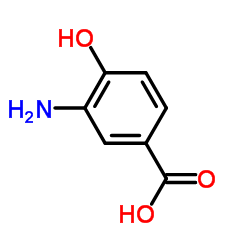GriC and GriD constitute a carboxylic acid reductase involved in grixazone biosynthesis in Streptomyces griseus.
Hirokazu Suzuki, Yasuo Ohnishi, Sueharu Horinouchi
Index: J. Antibiot. 60(6) , 380-7, (2007)
Full Text: HTML
Abstract
In grixazone biosynthesis by Streptomyces griseus, a key intermediate 3-amino-4-hydroxybenzoic acid (3,4-AHBA) is converted to another key intermediate 3-amino-4-hydroxybenzaldehyde (3,4-AHBAL). Two genes griC and griD in the grixazone biosynthesis gene cluster were found to be responsible for this conversion, because disruption of each gene resulted in the extracellular accumulation of 3-acetylamino-4-hydroxybenzoic acid, a shunt product from 3,4-AHBA. Significant sequence similarity of GriC to AMP-binding proteins and of GriD to NAD(P)-dependent aldehyde dehydrogenases suggested that GriC and GriD constituted an ATP- and NAD(P)-dependent carboxylic acid reductase (CAR) catalyzing reduction of 3,4-AHBA to produce 3,4-AHBAL through acyl-AMP formation, as is found for the reactions catalyzed by some CARs. griG encoding a benzoate transporter homologue in the grixazone biosynthesis gene cluster was nonessential for grixazone biosynthesis but probably enhanced the membrane permeability for 3,4-AHBA. Simultaneous overexpression of griC, griD, and griG in S. griseus mutant cells deficient in an acetyltransferase responsible for N-acetylation of 3,4-AHBA led to efficient bioconversion of exogenously added 3,4-AHBA to 3,4-AHBAL. This system also turned out to be useful for reduction of some aryl carboxylates to the corresponding aryl aldehydes.
Related Compounds
| Structure | Name/CAS No. | Molecular Formula | Articles |
|---|---|---|---|
 |
3-Amino-4-hydroxybenzoic acid
CAS:1571-72-8 |
C7H7NO3 |
|
3D-QSAR and molecular docking studies of benzaldehyde thiose...
2007-03-01 [Bioorg. Med. Chem. 15 , 2006-15, (2007)] |
|
Novel benzene ring biosynthesis from C(3) and C(4) primary m...
2006-12-01 [J. Biol. Chem. 281(48) , 36944-51, (2006)] |
|
Arylamine N-acetyltransferase responsible for acetylation of...
2007-03-01 [J. Bacteriol. 189(5) , 2155-9, (2007)] |
|
Experience with cheetan in management of HIV infection.
1997-07-01 [East Afr. Med. J. 74(7) , 460-1, (1997)] |